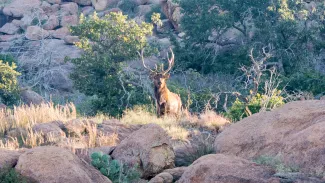
Late September finds the bulls with gleaming antlers, swollen necks, and short tempers. Elk are polygamous, and once the mating season arrives, bulls assemble females, or cows, into harems. A harem that contains as many cows as a bull can successfully defend from competing bulls.
Bull elk use a high-pitched, flute-like call, or bugle, to attract cows and to announce their willingness to defend their cows and breeding territory against competing males. The fall mating season is the only time males and females are commonly found together.
In Oklahoma, the largest free-ranging elk herds can be found in the Wichita Mountains Wildlife Refuge, as well as at Pushmataha, Cookson Hills, Spavinaw, and Cherokee wildlife management areas. Small herds also inhabit private land in Kiowa, Comanche, and Caddo counties.
Because their natural predators have largely disappeared, unmanaged elk may overpopulate their available range, causing habitat degradation. In 1966, the Wildlife Department and the United States Fish and Wildlife Service reached a cooperative agreement that provided for an annual controlled hunt to manage elk populations at the Wichita Mountains NWR. Since then, the agreement has proven instrumental in controlling herd numbers while allowing a few fortunate hunters, selected through an annual drawing conducted by the Wildlife Department, the opportunity to pursue the American elk in its native habitat.
Hunting & Safety Tips
Pagination
- Previous page
- Page 2
Cleaning & Processing Tips





